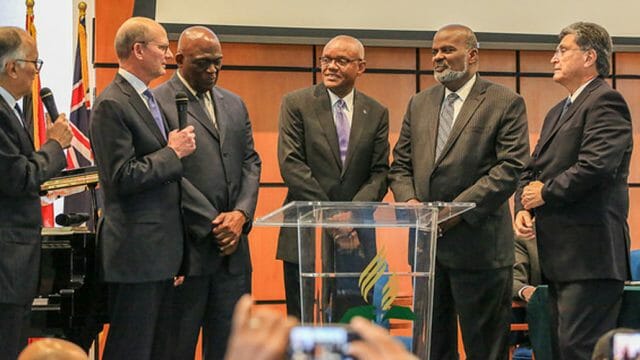The Reformation of the sixteenth century was first and foremost a hermeneutical reformation.

Throughout the ages God has always had a remnant who remained faithful to Him and His word, regardless of the circumstances. For instance, in the degraded antediluvian world, Noah and his family trusted and obeyed God’s word, which seemed illogical and unfulfillable (Gen. 6:1-9:29; Heb. 11:7). When King Ahab and his pagan wife Jezebel led Israel into profound idolatry, Elijah, Elisha, and another seven thousand remained on God’s side and did not worship Baal (1 Kings 16-19). In the court of Babylon Daniel and his three friends remained loyal to God under the most severe socio-political pressures (Dan. 1:1-21; 3:1-30; 6:1-28). Hebrews 11 provides several other inspiring examples of loyalty.
Christ Himself was “obedient to the point of death, even the death of the cross” (Phil. 2:8; cf. Matt. 26:39, 42, 44). Many of His early disciples and later followers chose rather to die than to betray their Master and His teachings. During the Middle Ages, the Catholic higher clergy removed the Bible from the laity and accommodated its teachings to their own extra-biblical traditions. But such fearless pre-reformers as John Wycliffe, John Hus, Jerome of Prague, and the Waldensians tried to restore the sole headship of Christ and the exclusive authority of the Scriptures. They helped to pave the way for the Protestant renewed emphasis on the authority of the Bible as the trustworthy Word of God.
The Protestant Reformation
The Reformation of the sixteenth century was first and foremost a hermeneutical reformation that shook the authority of the Roman Catholic Church and allowed the Bible once again the right to speak directly to every believer. The Bible was restored to its central place through the principles of sola Scriptura (the exclusiveness of Scripture) and tota Scriptura (the totality of Scripture). Beyond salvation by grace through faith (Eph. 2:8-10), however, the Magisterial Reformers (including Luther, Zwingli, and Calvin) did not go far enough toward restoring other major Bible doctrines that had become obscured in the post-Apostolic era. Even so, the Reformers laid the foundation to rediscover key hermeneutical principles that in time would lead toward more thorough doctrinal restorations.1
Much more than just an event in time, the Reformation should be viewed as an enduring process of always breaking away from error and moving ever closer to the teachings of Scripture, as well-expressed by the motto, “the reformed church, always being reformed according to the Word of God.”2 Regrettably, however, the notion of an ongoing reformation was largely lost under the post-Reformation tendency of binding the understanding of Scripture to the authority of ecclesiastical creeds. But new restoration movements emerged, reemphasizing the authority of the Bible and unfolding some of its crucial teachings. Many of them subscribed to the sola Scriptura principle, but no other contemporary movement has taken the tota Scriptura principle as serious as Seventh-day Adventists did.
The Adventist Reformation
We usually speak of early Adventism as a prophetic movement which eventually organized itself into a church. From an ecclesiological perspective, this is indeed the case. But from a hermeneutical viewpoint, we can see Adventism as a major nineteenth-century reformation, which used the Protestant hermeneutical principles and applied them more consistently and more extensively to the Scriptures. Hence, several important biblical teachings were rediscovered and integrated into a solid platform of truth.3 According to Ellen White, “of all the great religious movements since the days of the apostles, none have been more free from human imperfection and the wiles of Satan than was that of the autumn of 1844.”4
In 1894, Ellen White stated, “The truth for this time is broad in its outlines, far reaching, embracing many doctrines; but these doctrines are not detached items, which mean little; they are united by golden threads, forming a complete whole, with Christ as the living center. The truths we present from the Bible are as firm and immovable as the throne of God.”5 This conviction, however, should never be used as an excuse to stop our ongoing search for biblical truth. She also added, “There is no excuse for anyone in taking the position that there is no more truth to be revealed, and that all our expositions of Scripture are without error.”6
Thus, since the beginning of human history, God’s remnant has always been characterized by unconditional faithfulness to God and to “every word that proceeds from the mouth of God” (Matt. 4:4). No wonder that in the last days (Rev. 12:17; 14:12), God will have also “a people upon the earth to maintain the Bible, and the Bible only, as the standard of all doctrines and the basis of all reforms.”7 Realizing that the search for truth is an endless process, we can affirm that a true member of God’s people is someone who lives according to the light already understood from God’s Word and who continuously seeks for new glimpses of light.
Alberto R. Timm hails originally from Brazil and currently serves as an associate director of the Ellen G. White Estate.
1 Alberto R. Timm, “Historical Background of Adventist Biblical Interpretation,” in George W. Reid, ed., Understanding Scripture: An Adventist Approach (Silver Spring, MD: Biblical Research Institute, 2005), pp. 3-4.
2 Edward A. Dowey, “Always to Be Reformed,” in John C. Purdy, ed., Always Being Reformed: The Future of Church Education (Philadelphia, PA: Geneva Press, 1985), pp. 9-10. See also Michael Bush, “Calvin and the Reformanda Sayings,” in Herman J. Selderhuis, ed., Calvinus sacrarum literarum interpres: Papers of the International Congress on Calvin Research (Göttingen: Vandenhoeck & Ruprecht, 2008), pp. 285-299.
3 See Alberto R. Timm, The Sanctuary and the Three Angels’ Messages: Integrating Factors in the Development of Seventh-day Adventist Doctrines (Berrien Springs, MI: Adventist Theological Society Publications, 1995).
4 Ellen G. White, The Great Controversy (Mountain View, Calif.: Pacific Press Publ. Assn., 1950), p. 401.
5 Ellen G. White, Selected Messages (Washington, D.C.: Review and Herald Publ. Assn., 1958), book 2, p. 87.
6 Ellen G. White, Counsels to Writers and Editors (Nashville, Tenn.: Southern Publ. Assn., 1946), p. 35; see also pp. 28-54.
7 White, The Great Controversy, p. 595.








